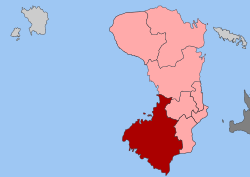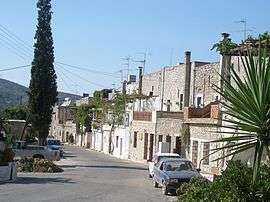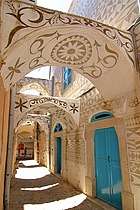Mastichochoria
Mastichochoria (Greek: Μαστιχοχώρια, Greek pronunciation: [mastixoˈxorʝʲa], lit. "the mastic villages" in English) is a former municipality on the island of Chios, North Aegean, Greece. Since the 2011 local government reform it is part of the municipality Chios, of which it is a municipal unit.[2] It is located in the southwestern and extreme southern part of the island. It is the largest municipal unit in land area on Chios at 211.687 km2.[3] Its population was 3,672 at the 2001 census. The seat of the municipality was Pyrgi (pop. 755). The next largest villages are Kalamotí (569), Armólia (442), Mestá (337), and Lithío (397). The small coastal village of Emporeios (47) boasts an archaeological site.
Mastichochoria Μαστιχοχώρια | |
|---|---|
 Central square of Pyrgi | |
 Mastichochoria Location within the regional unit  | |
| Coordinates: 38°15′N 25°59′E | |
| Country | Greece |
| Administrative region | North Aegean |
| Regional unit | Chios |
| Municipality | Chios |
| • Municipal unit | 211.7 km2 (81.7 sq mi) |
| Population (2011)[1] | |
| • Municipal unit | 3,672 |
| • Municipal unit density | 17/km2 (45/sq mi) |
| Time zone | UTC+2 (EET) |
| • Summer (DST) | UTC+3 (EEST) |
| Vehicle registration | ΧΙ |
This area is well known for the production of mastic, from which it derives its name. Mastic is the hardened resin of the mastic tree and is only harvested on Chios, being a major part of the local economy. In the village of Pyrgi, there is even a small Museum of Mastic.
Within the European Union, Chios mastika, a mastic-flavoured liqueur has a protected designation of origin. The island's mastic production is controlled by a co-operative of medieval villages. The local producers are united under the Chios Gum Mastic Growers Association.
Chios Gum Mastic Growers Association
Founded in 1938, the Chios Gum Mastic Growers Association (Greek: Ένωση Μαστιχοπαραγωγών Χίου), abbreviated CGMGA, is a cooperative organisation and acts as the collective representative organ of twenty primary cooperatives totalling nearly 5000 members in the twenty-four villages of southern Chios.[4] It has the exclusive management of Chios mastika in Greece and abroad.[5] Its international equivalent in French is the Union des Producteurs de Gomme Mastic de Chio.
The organisation is mainly involved with the management of the agricultural production, supporting local growers, stimulating research, and providing legal assistance.
The CGMGA has a Board of Directors consists of nine members. Three members are permanent: these are the Director of the Agricultural Service, the technical supervisor of the ATE bank and the Commissioner of NCGAC. The other six board positions are elected.[6]
Museum of Mastic
On 11 June 2016,[8] the Chios Mastic Museum opened its doors in Rachi, on the southern part of Chios in the region of the Mastichochoria. It offers a permanent exhibition about mastiha production on the island, explaining its history and cultivation techniques as well as demonstrating its different uses today.[9]
Historical events
In the Chios Massacre of 1822, during the Ottoman rule of Chios, the people of Mastichochoria were spared so that they could continue serve the Sultan by providing him and his harem with mastic.
In 2012 the Mastichochoria and its trees were threatened by a wildfire that broke out in the southern part of the island.
References
- "Απογραφή Πληθυσμού - Κατοικιών 2011. ΜΟΝΙΜΟΣ Πληθυσμός" (in Greek). Hellenic Statistical Authority.
- Kallikratis law Greece Ministry of Interior (in Greek)
- "Population & housing census 2001 (incl. area and average elevation)" (PDF) (in Greek). National Statistical Service of Greece. Archived from the original (PDF) on 2015-09-21.
- Belles, Christos (2005). Mastiha Island. Athens: Ellinika Gramatta Press. pp. 212–13. ISBN 978-960-89048-9-7.
- "Mastiha Growers Association". www.gummastic.gr. Retrieved 2016-06-20.
- Belles, Christos (2005). Mastiha Island. Athens: Ellinika Gramatta Press. pp. 210–11. ISBN 978-960-89048-9-7.
- Belles, Christos (2005). Mastiha Island. Athens: Ellinika Gramatta Press. p. 213. ISBN 978-960-89048-9-7.
- Evgenia Choros. "Chios Mastic Museum Opened Its Doors on June 11th". Retrieved 2016-06-21.
- "The Chios Mastiha Museum". Retrieved 2016-06-21.
External links
- Mastichochoria - official website
- pictures from Mastichochoria in Panoramio website
| Look up mastichochoria in Wiktionary, the free dictionary. |
| Wikimedia Commons has media related to Mastichochoria. |


